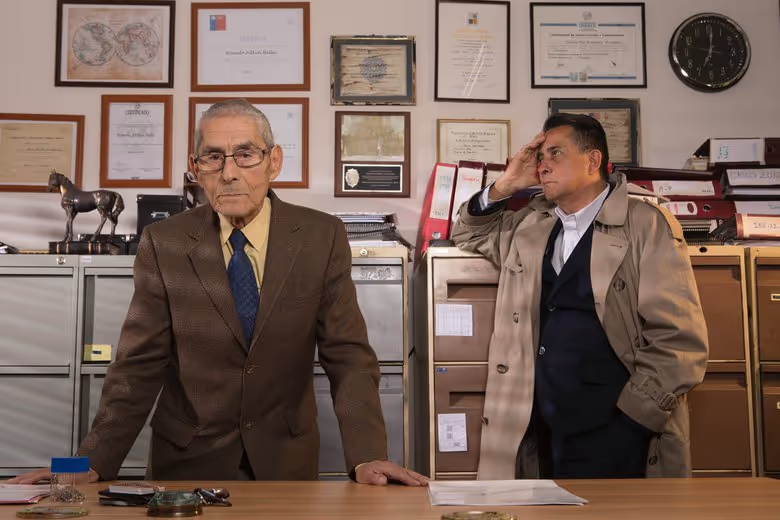The Mole Agent: Rethinking Old Age Resources and Standards
Resources and Standards

Resources
The Film
POV: The Mole Agent
www.amdoc.org/watch/moleagent
The film’s official POV site includes a discussion guide with additional activity ideas and resources.
Cinema Delicatessen: Chez Jolie Coiffure
www.cinemadelicatessen.nl/film/the-mole-agent
The distributor's official website provides information and articles on the film and filmmakers.
POV: Media Literacy Questions for Analyzing POV Films
www.pbs.org/pov/educators/media-literacy.php
This list of questions provides a useful starting point for leading rich discussions that challenge students to think critically about documentaries.
National Institute on Aging Information Center
www.nia.nih.gov
Federal Agency with resources and information in English and Spanish on the nature of aging and extending the healthy, active years of life
The National Council on the Aging
www.ncoa.org
Partners with nonprofit organizations, government, and business to provide community programs and services, online help, and advocacy to help people aged 60+ meet the challenges of aging.
American Association of Retired Persons (AARP)
www.aarp.org
Provides resources, networking and support for Americans over the age of 50
United Nations Division for Social Policy and Development: Aging
www.un.org/development/desa/ageing
This U.N. program aims to raise awareness about the global situation of older persons and increase recognition of human rights for older persons.
Stanford Center on Longevity
longevity.stanford.edu
SCL offers research videos, podcasts, and events highlighting scientific discoveries, technological advances, and social programs to improve the understanding and experience of aging.
The FrameWorks Institute: Aging
www.frameworksinstitute.org/issues/aging
The FrameWorks Institute is a nonprofit organization that offers research, resources, and training to shift thinking about issues such as aging and older people.
Standards
CCSS.ELA-Literacy.SL.8.1 Engage effectively in a range of collaborative discussions (one- on-one, in groups and teacher-led) with diverse partners on grade 8 topics, texts and issues, building on others’ ideas and expressing their own clearly.
CCSS.SL.9-10.1 Initiate and participate effectively in a range of collaborative discussions (one-on-one, in groups and teacher-led) with diverse partners on grades 9-10 topics, texts and issues, building on others’ ideas and expressing their own clearly and persuasively.
CCSS.ELA-Literacy.SL.11-12.1 Initiate and participate effectively in a range of collaborative discussions (one-on-one, in groups and teacher-led) with diverse partners on grades 11-12 topics, texts and issues, building on others’ ideas and expressing their own clearly and persuasively.
CCSS.ELA-Literacy.SL.8.2 Analyze the purpose of information presented in diverse media and formats (e.g., visually, quantitatively, orally) and evaluate the motives (e.g., social, commercial, political) behind its presentation.
CCSS.ELA-Literacy.SL.9-10.2 Integrate multiple sources of information presented in diverse media or formats (e.g., visually, quantitatively, orally) evaluating the credibility and accuracy of each source.
CCSS.ELA-Literacy.SL.11-12.2 Integrate multiple sources of information presented in diverse formats and media (e.g., visually, quantitatively, orally) in order to make informed decisions and solve problems, evaluating the credibility and accuracy of each source and noting any discrepancies among the data.
CCSS.ELA-Literacy.SL.8.4 Present claims and findings, emphasizing salient points in a focused, coherent manner with relevant evidence, sound valid reasoning and well-chosen details; use appropriate eye contact, adequate volume and clear pronunciation.
CCSS.ELA-Literacy.SL.9-10.4 Present information, findings and supporting evidence clearly, concisely and logically such that listeners can follow the line of reasoning and the organization, development, substance and style are appropriate to purpose, audience and task.
CCSS.ELA-Literacy.SL.11-12.4 Present information, findings and supporting evidence, conveying a clear and distinct perspective, such that listeners can follow the line of reasoning, alternative or opposing perspectives are addressed and the organization, development, substance and style are appropriate to purpose, audience and a range of formal and informal tasks.
CCSS.ELA-Literacy.SL.8.5 Integrate multimedia and visual displays into presentations to clarify information, strengthen claims and evidence and add interest.
CCSS.ELA-Literacy.SL.9-10.5 Make strategic use of digital media (e.g., textual, graphical, audio, visual and interactive elements) in presentations to enhance understanding of findings, reasoning and evidence and to add interest.
CCSS.ELA-Literacy.SL.11-12.5 Make strategic use of digital media (e.g., textual, graphical, audio, visual and interactive elements) in presentations to enhance understanding of findings, reasoning and evidence and to add interest.
CCSS.ELA-Literacy.RH.6-8.7 Integrate visual information (e.g., in charts, graphs, photographs, videos or maps) with other information in print and digital texts.
CCSS.ELA-Literacy.RH.9-10.7 Integrate quantitative or technical analysis (e.g., charts, research data) with qualitative analysis in print or digital text.
CCSS.ELA-Literacy.RH.11-12.7 Integrate and evaluate multiple sources of information presented in diverse formats and media (e.g., visually, quantitatively, as well as in words) in order to address a question or solve a problem.
